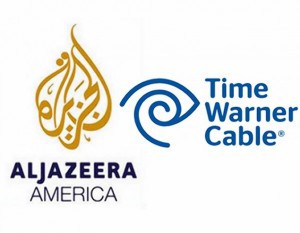 Time Warner Cable, the nation’s second largest cable operator, has agreed to carry Al Jazeera America on its cable lineup nationwide, giving the network 10 million more potential viewers.
Time Warner Cable, the nation’s second largest cable operator, has agreed to carry Al Jazeera America on its cable lineup nationwide, giving the network 10 million more potential viewers.
The contract, to be announced later today, will bring the English language U.S.-focused news channel to major cities, including Los Angeles and New York within weeks. Time Warner Cable customers in other cities will see the channel added by next March.
Al Jazeera America launched two months ago and has not been an initial ratings success. Despite being available in 44 million homes, fewer than 25,000 people watch the news channel at any given time. The ratings are comparable to Fox Business Channel after it launched.
“We said in January that we would consider Al Jazeera America,” Melinda Witmer, the chief video and content officer for Time Warner Cable. “Now that the channel is live, we think that it would be of value to our customers and are pleased to make it available.”
Time Warner Cable threw Al Jazeera’s predecessor, Current TV, off lineups the instant the network was sold to the Qatar-based news channel. AT&T U-verse also dropped Al Jazeera English just as it premiered, sparking a lawsuit.
The news network is touting the carriage agreement with Time Warner Cable as evidence the network is being taken seriously by cable industry executives. An Al Jazeera spokesman told the New York Times the company was in active negotiations with other cable and satellite providers to pick up the channel.
To win the agreement, Al Jazeera may have temporarily agreed to pay Time Warner Cable a launch fee described as compensation for marketing and ad support. Typically, cable networks receive payment for carriage, not the other way around.
Unlike Al Jazeera English, a global English language news channel intended for an international audience, Al Jazeera America is an American cable news channel, featuring recognizable news personalities including Soledad O’Brien and Ali Velshi, both formerly with CNN.


 Subscribe
Subscribe Efforts by New York’s largest cable operator to deregulate telephone service in New York, potentially cutting off delinquent ratepayers’ phone service at inconvenient times, has run into opposition from an Albany newspaper.
Efforts by New York’s largest cable operator to deregulate telephone service in New York, potentially cutting off delinquent ratepayers’ phone service at inconvenient times, has run into opposition from an Albany newspaper.


 The average owner of a large home that wants an alarm system, the ability to observe everything indoors and out, and remotely control doors, thermostats and electric outlets will pay AT&T $1,740 in installation fees and a recurring monthly charge of $69.95 a month for deluxe peace of mind.
The average owner of a large home that wants an alarm system, the ability to observe everything indoors and out, and remotely control doors, thermostats and electric outlets will pay AT&T $1,740 in installation fees and a recurring monthly charge of $69.95 a month for deluxe peace of mind.